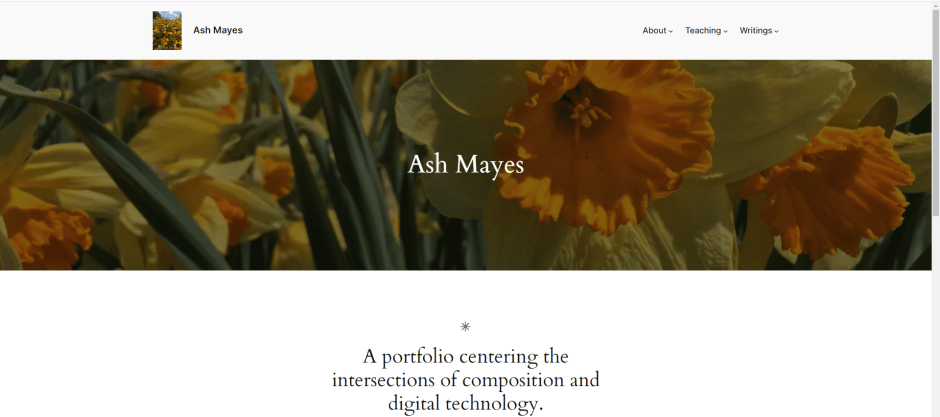Teaching with Technology Certificate
The Digital English Studio assists graduate students and teaching faculty in English who are working to earn Penn State’s Teaching with Technology Certificate. We help people craft teaching with technology philosophy statements and other reflective materials, integrate technology into their courses, and design digital teaching portfolios.
If you’re interested in earning a Teaching with Technology Certificate your first step is to contact us. We will then schedule an initial meeting with you to explain the process and create an action plan.
Certificate aspirants can learn more about the process for earning a Certificate here.
Portfolio Examples
Example portfolios can give you ideas about how to craft and organize your materials to create a successful portfolio of your own. We encourage you to browse the examples below to help get you started.
Background Readings
The following readings can help you craft a nuanced teaching with technology philosophy statement and reflection. All of the readings are available through the Penn State University Libraries.
- Phil Alexander et al. (2012): “Teaching with Technology: Remediating the Teaching Philosophy Statement”
This article discusses questions and issues related to teaching philosophies built specifically to address the use of technology. Although its additional discussions of remediation and context aren’t necessary for the Certificate, they still may provide you with insight into ways of thinking about non-traditional teaching philosophies.
- Casey Boyle, James J. Brown, Jr., and Steph Ceraso (2018): “The Digital: Rhetoric Behind and Beyond the Screen”
This article discusses how digital infrastructures and practices have become integral to everyday life among a number of related concepts like digital embodiment, ambience, and sensory connection. This piece is relatively advanced compared to other concept and theory readings in this list, and it can give you a sense of how digital rhetoric scholars are currently discussing technology in ways that matter both in the classroom and elsewhere.
- Michael Knievel (2009): “What is Humanistic about Computers and Writing? Historical Patterns and Contemporary Possibilities for the Field”
This article traces the emergence and place of computers within humanism. If you have been formally trained in another area of rhetoric or a different humanistic discipline, this piece is good for situating computers and writing and challenging familiar humanistic notions and assumptions.
- Elizabeth Losh (2014): The War on Learning: Gaining Ground in the Digital University
Although this is a book and therefore more of a time commitment than the other readings on this list, it is an excellent resource for those who want to strengthen their understanding of digital and technological teaching and learning. Losh discusses pedagogical surveillance, critical perspectives for thinking about technology, and advantages and disadvantages of using various forms of technology in pedagogical practice.
- Lilian W. Mina (2019): “Analyzing and Theorizing Writing Teachers’ Approaches to Using New Media Technologies”
This article discusses different approaches and theoretical frames for teaching with technology and advocates for a critical approach. If you are still working to articulate a nuanced theory of technology use in the classroom for your portfolio, you might find sections of this reading useful.
- Joy Robinson et al. (2019): “State of the Field: Teaching with Digital Tools in the Writing and Communication Classroom”
This article discusses how writing and communication teachers select and deploy digital technologies in their pedagogical activities. Additionally, it discusses the value and limitations of these approaches. This piece might help you understand how your own technology-based teaching philosophy and approaches relate to field-specific practices and goals.
- Cynthia L. Selfe and Richard J. Selfe, Jr. (1994): “The Politics of the Interface: Power and Its Exercise in Electronic Contact Zones”
This article challenges notions of technological neutrality and argues for a critical technological perspective essential to those who study and deploy digital rhetorical practices. In fact, many of the ideas in this article are so foundational that they are now commonplace or even assumed in a vast array of scholarly work.


